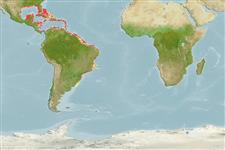Actinopterygii (ray-finned fishes) >
Perciformes (Perch-likes) >
Centropomidae (Snooks)
Etymology: Centropomus: Greek, kentron = sting + Greek, poma, -atos = cover, operculum (Ref. 45335).
Environment / Climate / Range
Ecology
Marine; freshwater; brackish; reef-associated; amphidromous (Ref. 51243); depth range ? - 22 m (Ref. 26912). Tropical; 25°C - 31°C (Ref. 36880), preferred 27°C (Ref. 107945); 30°N - 35°S, 98°W - 33°W
Western Atlantic: southern Florida (USA), southeastern coast of the Gulf of Mexico, most of the Antilles and Caribbean coast of Central and South America extending southward to Rio de Janeiro, Brazil; also North Carolina and Texas, USA (Ref. 7251).
Length at first maturity / Size / Weight / Age
Maturity: Lm ?, range 42 - ? cm
Max length : 140 cm TL male/unsexed; (Ref. 9710); common length : 50.0 cm TL male/unsexed; (Ref. 3713); max. published weight: 24.3 kg (Ref. 4699); max. reported age: 7 years (Ref. 12193)
Adults inhabit coastal waters, estuaries and lagoons, penetrating into freshwater; usually at depths less than 20 m (Ref. 3713). Feed on fishes (Gobiidae, Gerreidae, Engraulidae) and crustaceans (shrimps and crabs) (Ref. 35237). Mature individuals congregate at mouths of passes and rivers during the spawning season, May through September (Ref. 3713). Seasonal movements into freshwater occur but poorly understood (Ref. 3713). Marketed fresh (Ref. 5712). Valued game fish and an excellent food fish (Ref. 26938). The world record for hook and line is a 53-lb., 10 ounce fish caught at Parismina Ranch, Costa Rica (Ref. 13442).
Also Ref. 103751.
Robins, C.R. and G.C. Ray, 1986. A field guide to Atlantic coast fishes of North America. Houghton Mifflin Company, Boston, U.S.A. 354 p. (Ref. 7251)
IUCN Red List Status (Ref. 115185)
CITES (Ref. 94142)
Not Evaluated
Threat to humans
Harmless
Human uses
Fisheries: commercial; aquaculture: commercial; gamefish: yes
More information
ReferencesAquacultureAquaculture profileStrainsGeneticsAllele frequenciesHeritabilityDiseasesProcessingMass conversion
Tools
Can't connect to MySQL database fbquizv2. Errorcode: Too many connections
